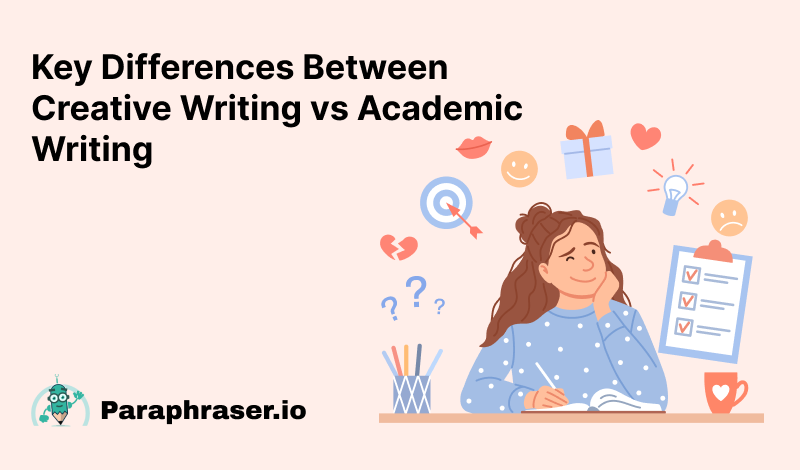
Key Differences Between Creative Writing vs Academic Writing
Writing is one of the most challenging disciplines to master completely. That’s mainly because it contains the involvement of different writing types. Out of those, two of the most popular ones are creative and academic writing.
The academic and creative types belong to two completely different sections of the writing world. Although people, often beginners, find these two kinds similar, they have some major differences. If you are curious about those dissimilarities, this is the place where you’ll get its answer.
In this blog, we’ll help you successfully differentiate the creative and academic forms of writing. To achieve our goal here, we’ll discuss their fundamental differences. But before getting to the elephant in the room, we’ll share the core concepts of these types. Doing so will help you better understand each difference. So, let’s delve in!
Introduction and Example of Creative Writing
As the name suggests, creative writing is a form of writing that focuses more on creativity. Therefore, writers often use imaginative and unique ways to convey emotions, ideas, and stories here. In fact, that’s the main reason why the expressions and words used in this writing type go beyond traditional literature. These are some of the most common examples of creative writing:
-
Creative nonfiction
-
Flash Fiction
-
Memoirs
-
Novels
-
Poetry
-
Plays
-
Screenplays
-
Short Stories
Quick Overview and Example of Academic Writing
On the other hand, academic writing is a more formal style of writing text. Therefore, it is most common for scholarly publications and educational institutions, like schools, colleges, and universities. Due to the nature of this writing form, it requires expressing the information clearly and precisely.
In addition to following a formal style, this writing type adheres to a structured format and specific style guides, such as APA, MLA, and Chicago. If you are interested in enhancing their academic writing skills, here are some of the best writing tips for writing academic papers for in-depth guidance and strategies. These are some of the most famous examples of academic writing:
-
Dissertations or theses
-
Lab Reports
-
Literature Reviews
-
Research Papers
-
Research Proposals
The Key Differences between Creative Writing & Academic Writing
You may have developed a complete understanding of the core concepts of academic and creative writing by now. If so, let’s move on to their key differences. So, these are the five major differences that separate creative writing from academic writing:
Purpose
As the aforementioned concept of creative writing indicates, it involves using imagery and imagination. Therefore, this type of writing intends to entertain, evoke emotions (creativity and imagination), and inspire readers by focusing on character development and storytelling.
However, academic writing aims to educate and inform readers by following specific formatting and citing conventions and guidelines. Therefore, it often involves a clear and well-structured presentation of evidence, facts, and logical reasoning to support the argument.
Style and Tone
The nature of creative writing gives writers the freedom to be innovative in expression and structure. Therefore, it often contains the involvement of dialogues, metaphors, narrations, symbolism, and vivid descriptions. These techniques allow creative write-ups to be more emotional, imaginative, and personal while engaging the readers. Here is an example that will better clarify the style and tone involved in creative writing:
Example: The forest whispered secrets in the wind, its ancient trees standing tall like guardians of forgotten stories. As the golden sunlight filtered through the leaves, the world seemed to pause in a magical stillness, inviting those who wandered into its depths to lose themselves in its quiet embrace.
Academic writing, on the other hand, follows a formal and neutral writing style. Therefore, you can’t offer personal opinions or show biases when conveying information in academic write-ups. Instead, you need to analyze and synthesize the information using clear language and following a proper structure, like headings, subheadings, and bullet points.
Example: The study of forest ecosystems reveals trees’ critical role in carbon sequestration and biodiversity preservation. According to recent research, old-growth forests act as significant carbon sinks, storing vast amounts of carbon dioxide while providing habitats for numerous species. Preserving these ecosystems is vital for mitigating climate change and maintaining ecological balance.
Language and Vocabulary
The language and vocabulary used to craft content in creative writing are generally broader and more innovative. For instance, rather than clearly conveying the information, you may need to incorporate metaphors, poetic expressions, or vivid imagery in this form of writing. Yet such creative freedom in writers means that sometimes a writer could borrow a phrase or even an idea inadvertently and find himself borrowing an element resembling something else. In such cases, a plagiarism checker proves pretty helpful for the original creative expression with no unintentional duplication of the work done. Otherwise, you won’t be able to capture the reader’s attention and evoke emotions. Here is a perfect example that will help you better understand the language and vocabulary of creative writing:
Written Using Simple Language and Vocabulary: The sun set over the mountains, and it became dark.
Rewritten With Creative Writing Language and Vocabulary: The sun dipped behind the jagged peaks, painting the sky in hues of fiery orange and deep purple as shadows stretched across the valley, slowly wrapping the world in a velvet cloak of night.
On the other hand, the language and vocabulary in academic writing must reflect your exploration of the field or topic. Therefore, the text crafted through this writing type often contains specialized and technical language. But using such vocabulary (or language) doesn’t mean compromising the clarity and precision of the overall document. To avoid doing so, we recommend using a grammar checker. By reviewing your text through such a tool, you can always guarantee accuracy when writing content. Here is an example that showcases the use of specialized and technical vocabulary while maintaining clarity and precision:
Example: In molecular biology, transcription refers to the synthesis of RNA from a DNA template, a fundamental mechanism in gene expression. RNA polymerase binds to the promoter region of the DNA, initiating the formation of a complementary RNA strand. This process is tightly regulated by transcription factors, which either enhance or suppress the rate of RNA synthesis depending on the cellular environment and specific regulatory sequences on the DNA.
In academic writing, paraphrasing plays a great role. Because clarity and accuracy are concerned, with excellent paraphrasing abilities, a writer can shift complex ideas from one's own perspective but without losing originality and yet without compromising on the source material. Thus, taking some time to read how paraphrasing skills help improve writing can be an investment in useful input in creative as well as academic writing.
Structure and Organization
By now, you may have understood that creative writing is synonymous with the art of exploring creativity and imagination. Therefore, it has a less structured format than academic writing. In fact, as creative writing involves character development and storytelling elements, its structure may evolve organically as the character or story unfolds.
However, the content of academic writing strictly follows a predefined structure and formatting style in order to ensure clarity and coherence. For instance, the most commonly used structure in this form of writing starts with an introduction, then the body content, and finishes with a conclusion. However, this structure is not set in stone, as it may change when including a thesis statement, supporting arguments, and evidence.
Audience
As mentioned earlier, creative writing involves correctly using imaginative words and expressions. Therefore, this writing form targets those who prefer imaginative storytelling or can interpret the story in their own way. But that’s not the case with academic writing.
Since academic writing generally revolves around the world of academia, it mainly targets the people of the educational community. So, its content is suitable for audiences who are either well-versed in the subject matter or have a keen interest in the topic.
Handle Creative and Academic Forms of Writing Like an Expert
Academic and creative writing requires following a particular writing style and tone. But if you don’t know the ins and outs of adhering to such writing tone or styles, you can get assistance from an AI paraphrasing tool. Due to artificial intelligence-based programming, such a tool has been trained to alter text wording and sentence structuring without modifying the original meaning. In fact, some versions of such utilities come with dedicated academic and creative modes. Therefore, you can use them to better follow the style and tone of your intended writing form.
Conclusion
Creative and academic writing are two of the most misunderstood types of writing, as people often get confused between them. However, these two writing forms clearly differ in terms of purpose, style, tone, language, vocabulary, and target audience. For instance, academic writing intends to analyze, inform, and present information in a logical and structured manner, whereas creative writing aims to entertain, evoke emotions, or inspire. So, make sure you understand these differences because if you don’t, you won’t be able to choose an appropriate style for your desired audience and purpose. For further insights on refining your academic writing, be sure to check out the writing tips for crafting academic papers.

